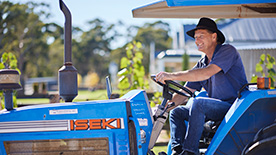972262
Simple steps to safety self audit tool results
 line
line
 line
line
 line
line
 line
line
 line
line
 line
line
 line
line
Your workers understand their role, and yours, in getting their work done safely.
Your responses indicate that safety roles, responsibilities and procedures have been defined.
Maintain commitment by:
- monitoring and reviewing your safety performance
- building safety into your future business plans
- promoting safety to your workers as a core business value
- providing feedback to your workers
- providing ongoing training so that everyone can enhance their skills
- making up to date information available to your workers so they improve their knowledge of safety issues and solutions.
Useful links
Your workers understand their role, and yours, in getting their work done safely.
Your responses indicate that safety roles, responsibilities and procedures have been defined.
Maintain commitment by:
- monitoring and reviewing your safety performance
- building safety into your future business plans
- promoting safety to your workers as a core business value
- providing feedback to your workers
- providing ongoing training so that everyone can enhance their skills
- making up to date information available to your workers so they improve their knowledge of safety issues and solutions.
Useful links
There are consultation procedures in place but these may not be working effectively or capturing all of your workers’ input.
Your responses indicate that you do consult with your workers but that it is inconsistent or that you may not reach all of your workers. You may also not provide feedback or consult with all relevant workers about health and safety matters.
What you can do to improve:
Make sure that your consultation process is suitable for the workplace
Your consultation process may need to be changed to take into account the different needs of your workers, the size of your business, the location of your site or sites if you have more than one, shift arrangements, transport workers or workers who work at client sites or any other special arrangements you may have with your workers. Some workers may not be able to attend regular meetings and may be missing vital information about their safety or changes in the workplace. You may need to introduce alternative methods of consulting with these workers.
Encourage workers to consult and always provide feedback
Sometimes workers can appear to lack the desire to consult but that may be as a result of the process of consultation rather than the consultation itself.
You can help address this by:
- Scheduling safety meetings as a priority. If safety meetings are held at the end of the day or a shift, you can run out of time and workers may feel rushed or too tired to contribute. Schedule safety meetings at the start of the day or shift so that there is enough time and workers are fresh and alert.
- Show that you value your workers’ views. You can develop a method to demonstrate to your workers that their concerns and feedback are considered. This could be in the form of an action plan or some other method that clearly shows you are listening. Sometimes workers are told about decisions rather than being consulted. If your workers believe their concerns are ignored they will be reluctant to participate in the consultation process. Don’t make safety decisions without regard to your workers’ feedback. If a decision is made that is contrary to worker views, provide reasons that clearly outline why.
- Involve your entire workforce. Some of your workers may be unaware of their WHS responsibilities. Train all of your workers in WHS consultation procedures, including your supervisors and managers. Workers from non-English speaking backgrounds and those with special needs should be consulted individually to ensure their concerns are addressed.
- To be effective, consultation needs to be consistent and inclusive and safety issues need to be addressed in a timely way. Discuss safety concerns as part of your regular workplace meetings rather than ad-hoc meetings. Making safety part of the regular agenda and having meaningful discussion will go a long way to integrating safety into the normal business culture and demonstrating to your workers that it is an important aspect of business operations.
Useful links
There are consultation procedures in place but these may not be working effectively or capturing all of your workers’ input.
Your responses indicate that you do consult with your workers but that it is inconsistent or that you may not reach all of your workers. You may also not provide feedback or consult with all relevant workers about health and safety matters.
What you can do to improve:
Make sure that your consultation process is suitable for the workplace
Your consultation process may need to be changed to take into account the different needs of your workers, the size of your business, the location of your site or sites if you have more than one, shift arrangements, transport workers or workers who work at client sites or any other special arrangements you may have with your workers. Some workers may not be able to attend regular meetings and may be missing vital information about their safety or changes in the workplace. You may need to introduce alternative methods of consulting with these workers.
Encourage workers to consult and always provide feedback
Sometimes workers can appear to lack the desire to consult but that may be as a result of the process of consultation rather than the consultation itself.
You can help address this by:
- Scheduling safety meetings as a priority. If safety meetings are held at the end of the day or a shift, you can run out of time and workers may feel rushed or too tired to contribute. Schedule safety meetings at the start of the day or shift so that there is enough time and workers are fresh and alert.
- Show that you value your workers’ views. You can develop a method to demonstrate to your workers that their concerns and feedback are considered. This could be in the form of an action plan or some other method that clearly shows you are listening. Sometimes workers are told about decisions rather than being consulted. If your workers believe their concerns are ignored they will be reluctant to participate in the consultation process. Don’t make safety decisions without regard to your workers’ feedback. If a decision is made that is contrary to worker views, provide reasons that clearly outline why.
- Involve your entire workforce. Some of your workers may be unaware of their WHS responsibilities. Train all of your workers in WHS consultation procedures, including your supervisors and managers. Workers from non-English speaking backgrounds and those with special needs should be consulted individually to ensure their concerns are addressed.
- To be effective, consultation needs to be consistent and inclusive and safety issues need to be addressed in a timely way. Discuss safety concerns as part of your regular workplace meetings rather than ad-hoc meetings. Making safety part of the regular agenda and having meaningful discussion will go a long way to integrating safety into the normal business culture and demonstrating to your workers that it is an important aspect of business operations.
Useful links
You identify and control hazards and risks and your workers are using safe work procedures to help them do their job safely.
Your responses indicate that you are effectively managing safety risks in your workplace through your safe work procedures.
What you can do to maintain this:
Continuously review your hazards and risks as well as your safe work procedures
Changes in the workplace including new equipment, new ways of doing things and even new workers can render hazard and risk controls obsolete. Make sure you keep reviewing your hazards and risks to make sure your controls remain effective. In the same way your safe work procedures should be reviewed regularly to ensure their effectiveness.
Useful links
You identify and control hazards and risks and your workers are using safe work procedures to help them do their job safely.
Your responses indicate that you are effectively managing safety risks in your workplace through your safe work procedures.
What you can do to maintain this:
Continuously review your hazards and risks as well as your safe work procedures
Changes in the workplace including new equipment, new ways of doing things and even new workers can render hazard and risk controls obsolete. Make sure you keep reviewing your hazards and risks to make sure your controls remain effective. In the same way your safe work procedures should be reviewed regularly to ensure their effectiveness.
Useful links
Your business views health and wellbeing of employees as a priority and plans and programmes are in place which address both physical and mental health issues.
Your responses indicate that you have a wellbeing program in place which actively encourages healthy lifestyle options, standard reporting systems include the reporting of workplaces issues that could contribute to work-related stress and measures are in place for the prevention of bullying and harassment.
What you can do to maintain this:
Put in place measures to review the effectiveness of your wellbeing program to ensure it continues to meet the needs of the workforce and any changing circumstances
Ensure leadership continues to take a visible and active involvement in the health and wellbeing program and staff are consulted so that the wellbeing program continues to address the needs of the workforce.
Monitor incident reporting systems to ensure work-related stressors are being reported and appropriate controls are put in place.
Continue to look for opportunities where health and wellbeing can be integrated and embedded into organisational systems and processes such as induction programs, WHS systems, education programs and overall business plans.
Consider how your business can evaluate the health and wellbeing program such as through changes in knowledge and attitudes of workers, records of participation, staff surveys, staff engagement levels and in the longer term, staff retention rates, absenteeism rates and workers compensation claims/premiums.
Your business views health and wellbeing of employees as a priority and plans and programmes are in place which address both physical and mental health issues.
Your responses indicate that you have a wellbeing program in place which actively encourages healthy lifestyle options, standard reporting systems include the reporting of workplaces issues that could contribute to work-related stress and measures are in place for the prevention of bullying and harassment.
What you can do to maintain this:
Put in place measures to review the effectiveness of your wellbeing program to ensure it continues to meet the needs of the workforce and any changing circumstances
Ensure leadership continues to take a visible and active involvement in the health and wellbeing program and staff are consulted so that the wellbeing program continues to address the needs of the workforce.
Monitor incident reporting systems to ensure work-related stressors are being reported and appropriate controls are put in place.
Continue to look for opportunities where health and wellbeing can be integrated and embedded into organisational systems and processes such as induction programs, WHS systems, education programs and overall business plans.
Consider how your business can evaluate the health and wellbeing program such as through changes in knowledge and attitudes of workers, records of participation, staff surveys, staff engagement levels and in the longer term, staff retention rates, absenteeism rates and workers compensation claims/premiums.
Your workers are adequately trained and supervised to be safe at work.
Your responses indicate that you have good processes in place for education and supervision of your workers.
What you can do to maintain this:
Continuously review your process of training, induction and supervision
Changes in the workplace including new equipment, new ways of doing things and even new workers can render old processes obsolete. Make sure you keep reviewing your hazards and risks to make sure your education and supervision remains effective.
Useful links
Your workers are adequately trained and supervised to be safe at work.
Your responses indicate that you have good processes in place for education and supervision of your workers.
What you can do to maintain this:
Continuously review your process of training, induction and supervision
Changes in the workplace including new equipment, new ways of doing things and even new workers can render old processes obsolete. Make sure you keep reviewing your hazards and risks to make sure your education and supervision remains effective.
Useful links
You are providing and maintaining a safe workplace for your workers.
Your responses indicate that you are regularly checking workplace work health and safety and identifying any changes or issues that may require you to reconsider existing procedures or processes.
You have a regular documented preventative maintenance programme in place and you ensure your plant and equipment is in safe working order.
You have an effective incident and injury reporting process in place. Your workers are trained in the process and all are notified of any outcome.
Your workplace has appropriate emergency procedures in place and these are tested regularly.
What you can do to maintain this:
Continuously review your process of training, induction and supervision
Changes in the workplace including new equipment, new ways of doing things and even new workers can render old processes obsolete. Make sure you keep reviewing your hazards and risks to make sure your education and supervision remains effective.
Useful links
You are providing and maintaining a safe workplace for your workers.
Your responses indicate that you are regularly checking workplace work health and safety and identifying any changes or issues that may require you to reconsider existing procedures or processes.
You have a regular documented preventative maintenance programme in place and you ensure your plant and equipment is in safe working order.
You have an effective incident and injury reporting process in place. Your workers are trained in the process and all are notified of any outcome.
Your workplace has appropriate emergency procedures in place and these are tested regularly.
What you can do to maintain this:
Continuously review your process of training, induction and supervision
Changes in the workplace including new equipment, new ways of doing things and even new workers can render old processes obsolete. Make sure you keep reviewing your hazards and risks to make sure your education and supervision remains effective.
Useful links
Your workers are reporting all incidents, they are investigated and corrective actions put in place as needed.
Your responses indicate that you have an established incident reporting procedure and that you investigate incidents as they occur. You also put in place and monitor corrective actions.
What you can do to maintain this:
Monitor and analyse your incident reports to identify any trends and help you to improve your safety
Use your incident reports and investigations to monitor your workplace safety and identify any gaps in your system. These reports can be a valuable tool in prevention by allowing you to address any emerging issues before they become too big or cause major injury.
Useful links
Your workers are reporting all incidents, they are investigated and corrective actions put in place as needed.
Your responses indicate that you have an established incident reporting procedure and that you investigate incidents as they occur. You also put in place and monitor corrective actions.
What you can do to maintain this:
Monitor and analyse your incident reports to identify any trends and help you to improve your safety
Use your incident reports and investigations to monitor your workplace safety and identify any gaps in your system. These reports can be a valuable tool in prevention by allowing you to address any emerging issues before they become too big or cause major injury.
Useful links
Need more help?
SafeWork SA
SafeWork SA’s WHS advisors can visit your workplace to help you understand your work health and safety responsibilities as well as provide practical support to improve your systems, practices and general approach to safety.
Phone: 1300 365 255
help.safework@sa.gov.au
www.safework.sa.gov.au
Twitter: @SafeWorkSA
Facebook: @safeworksa
ReturnToWorkSA
Phone: 13 18 55
Injury prevention: injuryprevention@rtwsa.com
Mentally healthy workplaces: mentallyhealthy@rtwsa.com
Return to work coordinator support service: coordinators@rtwsa.com
Action plan
| Hazard/Risk | Actions | Responsible | Review Date | Due Date | Complete Date | Comments |
|---|






 Date printed: 05 Jan 2026
Date printed: 05 Jan 2026

